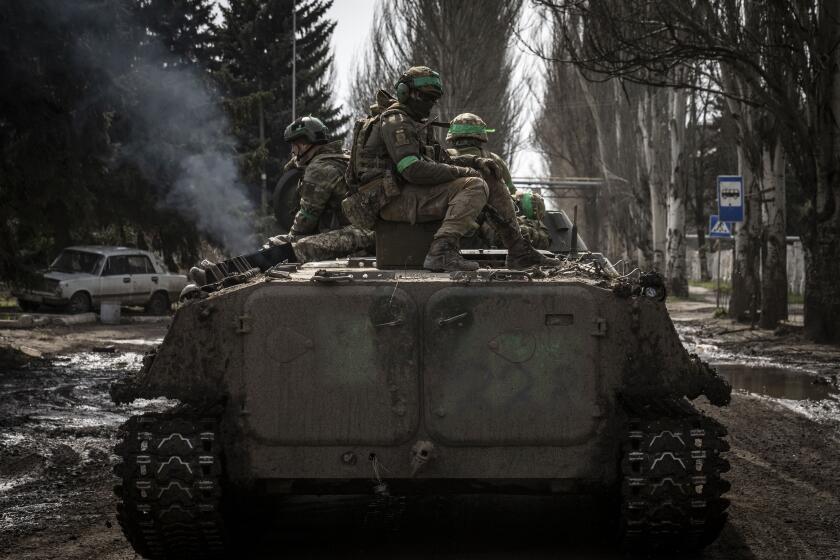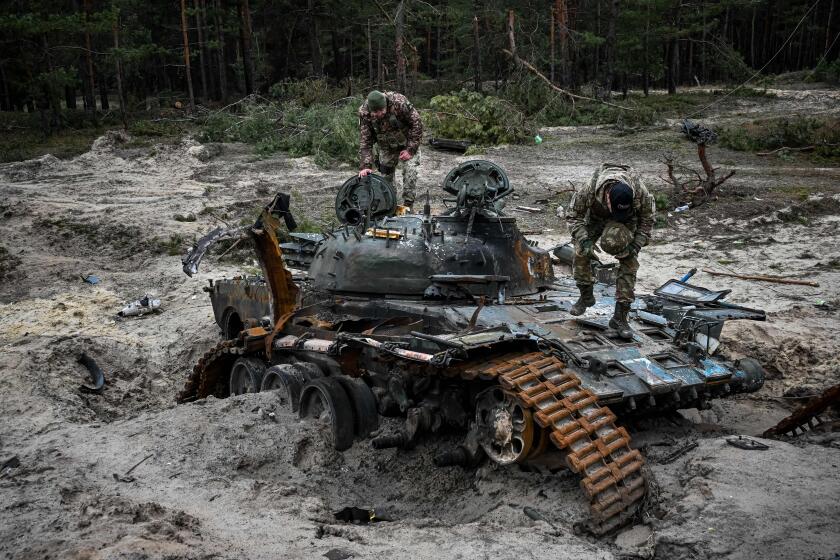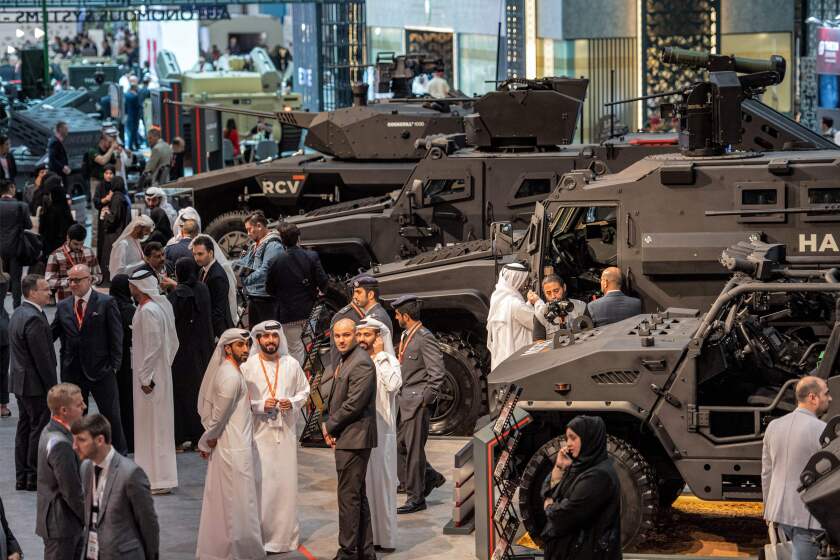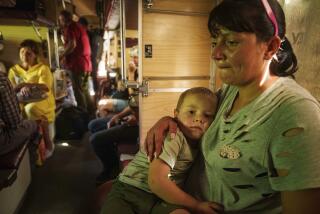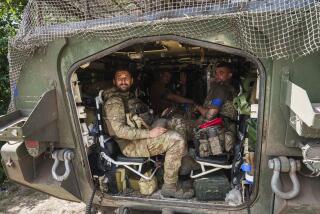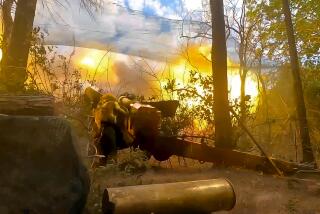The Ukraine war’s most vicious fight is happening in Bakhmut. A rare look inside
Los Angeles Times correspondent Nabih Bulos reveals that while the war against Russia may have slowed down on separate fronts, the eastern city of Bakhmut continues to be one of the hardest-fought contests in Ukraine.
BAKHMUT, Ukraine — The Ukrainian soldiers jumped out of the armored vehicle the moment it stopped, rushing to unload supplies before the Russian artillery began its deadly work.
It wasn’t fast enough. Barely 40 seconds later came the first shriek. The men hit the ground as the blast hit, the smell of cordite and dust going deep into their nostrils.
“Go, go, go, go,” one shouted. The others sprinted through a building’s smoke-filled courtyard, feet crunching over a carpet of broken glass, masonry and splintered wood. As they ran down the stairs, another shriek sounded above. Then another.
If war is hell, there’s a creditable case Bakhmut is its ninth circle. The city in Ukraine’s east, known in the past for little other than its first-class winery (established by Stalin in 1950), has become the battleground of this war’s longest and most vicious fight.
No building remains untouched by ordnance, no surface clear of war detritus. Traversing any neighborhood is a furtive dash through smoke-filled streets, scampering past the shattered, burning remains of well-appointed boulevards.
For the Ukrainian forces here, a simple resupply requires an armored vehicle — or a full-tilt gallop down the road, praying to avoid the omnipresent gaze of drones and that the innumerable chunks of metal whistling through the skies above don’t fall nearby.
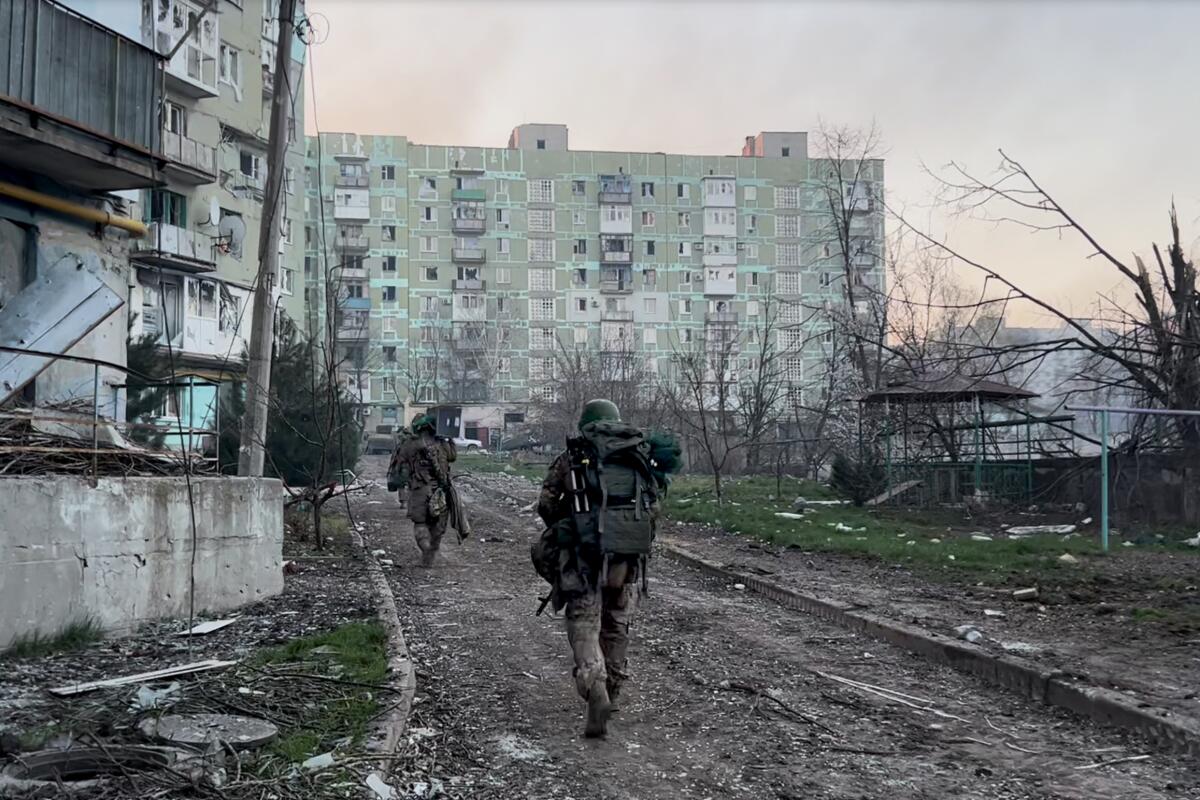
The two main roadways leading west out of the city are, in effect, artillery alleys. The Russians don’t control the roads, but are within range to blast any vehicle on them. The only recourse is to cut a winding path through muddy fields that can take anywhere from 20 minutes to an hour and still puts troops at risk from artillery.
As anticipation builds for a counteroffensive, Ukrainian forces are desperate to lay their hands on Western tanks that could help turn the war’s tide.
The soldiers’ ride into the city that day had been a touch-and-go affair; the Russians had tried to hit the armored vehicle twice when it was going through the mud, the driver said.
“You didn’t hear how they tried to f— us ? I had to push the pedal down,” he said to one of the soldiers nearby, before the newest artillery attack started up.
“Thanks for the ride,” the other retorted.
Bakhmut, once home to some 70,000 people, has become the site of the bloodiest combat in 14 months of war. The city at the edge of Russia-controlled territory in Donetsk isn’t a strategic prize, though it is a roadway hub that opens up to six other cities. From a war-plans perspective it has limited value.
But now, after so long, it appears to hold a psychological symbolism for the fighting forces on each side. Neither seems willing to let go, transforming Bakhmut into a churned-up moonscape of battered buildings, bombed-out vehicles and corpses. Russia and Ukraine both insist that fighting in Bakhmut makes their adversary expend men and materiel that would otherwise be deployed elsewhere, and that it buys time for their respective forces to prepare for the more significant battles ahead.
But observers say that’s a questionable strategy for Ukraine. Most of the forces fighting in Bakhmut are from Wagner, a Russian private military company, said Michael Kofman, a military analyst and director of the Russia studies program at CNA, a Virginia-based research institute.
The Ukrainian military’s surrender hotline, dubbed ‘I Want to Live,’ is enticing some Russian soldiers to quit the battlefield as the war drags on.
Though Bakhmut is a priority objective for the Russian military, the notion it was occupying a substantial number of regular forces was doubtful, Kofman said. Fighting alongside Wagner was Russian airborne but little else.
“Most elite units are deployed elsewhere along the front,” Kofman said.
Wagner has recruited tens of thousands of convicts from Russian prisons, promising them freedom and money if they come to fight. The group’s owner, Yevgeny Prigozhin, has close ties to Russian President Vladimir Putin and has staked his group’s reputation and his own on taking Bakhmut. The battle began in August.
Russia, at least for now, appears to have the upper hand, with army troops working to encircle Bakhmut from the farmlands on its periphery. Inside the city, the bare-knuckle brawl falls to Wagner, its recruits tasked with suicide dashes at Ukrainian lines to create openings for the rest to follow.
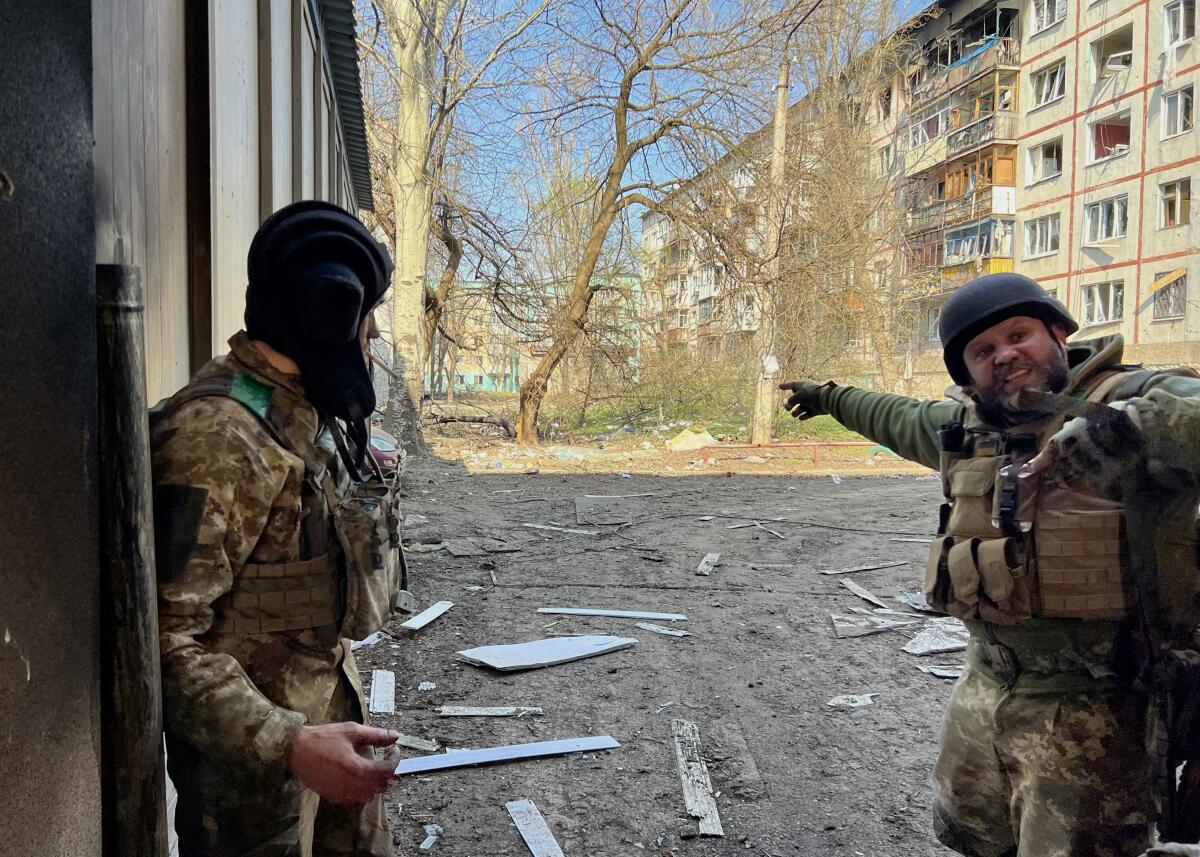
“First they use mortars, then automatic grenade launchers, then they get closer and use RPGs [rocket-propelled grenades]. Then when they’re assaulting us, they use automatic rifles and grenades,” said Lovah, one of the 251st Battalion’s reconnaissance scouts, who gave only his nickname.
One of the battalion’s commanders, Romul, 42, agreed.
“They’re trying to get close all the time. The distance between us is usually less than 150 feet,” Romul said.
“It’s a city battle. One house for us, the other is the enemy’s. That’s how close it is.”
That strategy has yielded some success. By the weekend, Russian forces added to their gains in Bakhmut’s southern, central and southwestern districts, according to an assessment released Saturday by Institute for the Study of War, a Washington-based think tank.
But it has meant deploying human wave tactics that come with a horrific cost, said Vasyl, 33, the head of the Ukrainian battalion’s mortar crew.
“This is the only reason why they’re able to attack our positions. They have much more infantry and can lose a lot of people,” Vasyl said.
“I attack a building where they’re bunkering, I see the mortar break through and they’re all dead. Then another wave comes to the same building, then a third.”
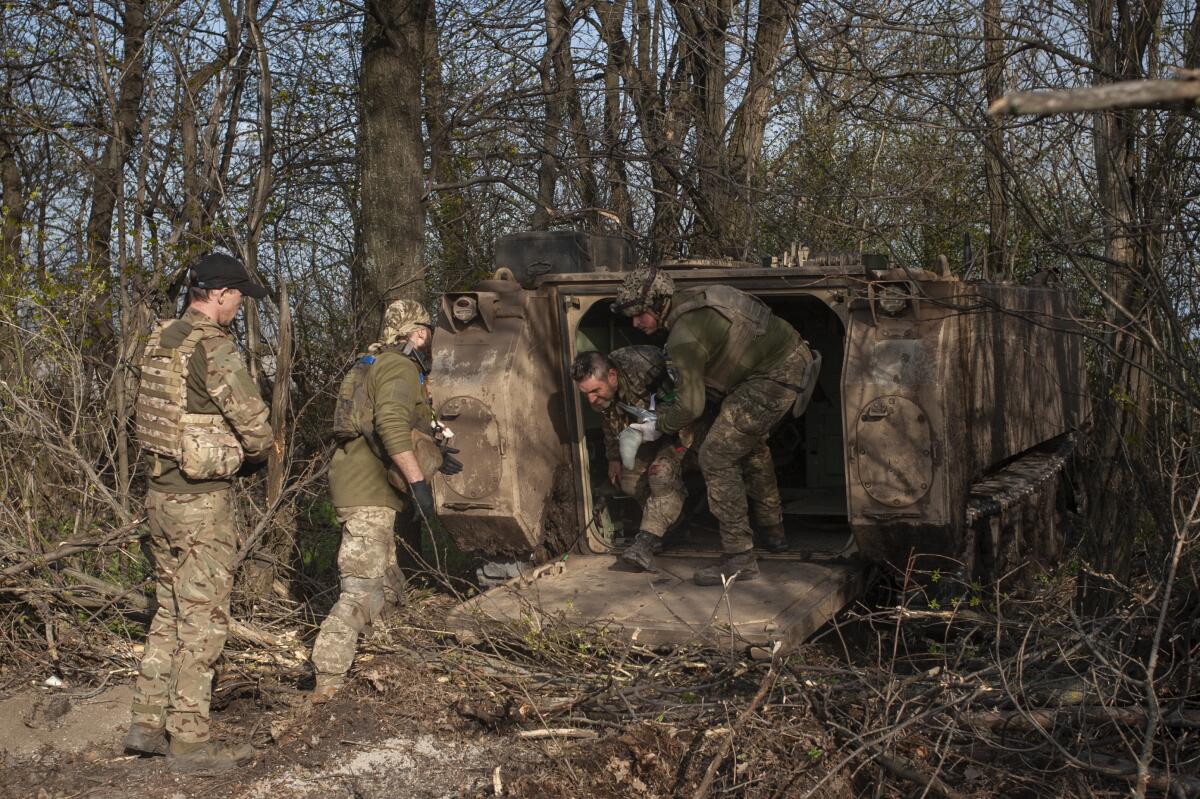
In an unmarked building somewhere in the city, Vasyl joined his colleagues in the 251st Battalion’s forward command center for their 12-hour shift, which began shortly after daybreak.
They sat before a trio of screens with maps and live feeds from drones above the city, along with tablets and phones with communication software. An intelligence analyst pointed out potential targets, tracked Russian troop movements and coordinated attacks with other units.
“Another day in paradise,” Romul quipped, looking over the shoulder of one of his colleagues to the center screen. It showed a row of obliterated cottages.
The atmosphere was that of a tensely quiet office, with all of them playing a game of whack-a-mole against the Russians, trying to catch and rain ordnance on them before they could attack Ukrainian forces.
Lacking the manpower of their adversary, the Ukrainians have had to use mortars to clear a path for their troops or defend them from Russian assault even when the enemy’s proximity makes that a risky endeavor.
“Our protocols tell me I have to stop shooting if I’m within 650 feet of our groups, but I can’t. They need support,” Vasyl said.
He recalled a moment two weeks ago when a Ukrainian squad in a building was surrounded by Russians. A tank had fired on the building, forcing the Ukrainians to retreat to the basement. They called on Vasyl to attack near the building and keep the Russians at bay. A drone video of the attack shows his mortar round hitting just beside the building and igniting a cache of explosives on the second floor. It forced the Russians back; the Ukrainians were safe.
The war in Ukraine has jacked the global arms trade, fueling a new appetite for materiel not just in Moscow and Kyiv but also around the world.
“I sweated a lot that day,” he said.
The flip side of the proximity problem is that there are often targets the Ukrainians leave alone for the simple fact that they lack sufficient ammunition. It’s a chronic problem for Ukraine’s forces, especially around Bakhmut, where units are firing thousands of shells a day. The Russians, despite reports of shortages, are mounting a virtually ceaseless barrage.
“If I didn’t have to aim, I could shoot 30 shells a minute,” Vasyl said, but he doesn’t have that luxury. He had to make sure to get the aim right at least from the sixth shot or consider abandoning the target.
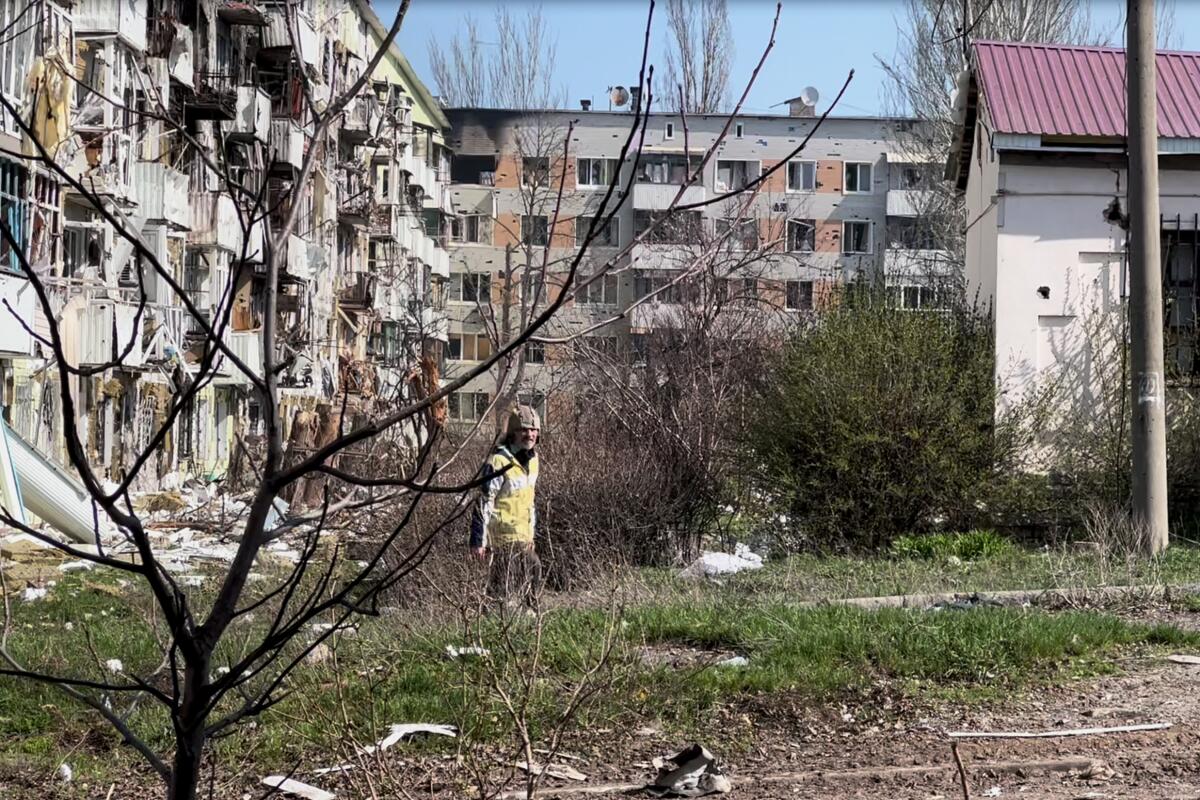
In this unrecognizable city, the civilian population has dropped to an estimated few thousand. The battalion members have taken to calling them “zombies” — because many show little reaction when shells fall near them.
“They’re just walking. Not even running. A shell falls, they go to the ground, cover their head, and then continue walking,” said Anton, a commander of a mechanized company, shaking his head.
That morning, he checked the corners for any movement, sticking close to the walls before he dipped into an open door and called down a basement for Alex, a 40-year-old living with his mother, Zoya, and his aunt, Lida.
“We don’t need food. Just cigarettes,” Alex said, explaining that only his mother was evacuating, leaving with the soldiers on a run out of the city. Though they had no electricity or running water, and though the Russians’ advance meant artillery was regularly reaching their street, the others insisted on staying — Alex for his cat, Lida for her dog.
“I love my home, I love my cat,” he said, smiling. Anton shook his head but radioed his headquarters and informed them Zoya would be coming.
But she wouldn’t be leaving that day.
Later that afternoon, an armored vehicle carrying some of the Ukrainian wounded roared up to the headquarters, loaded some equipment and raced out of the city. One of the soldiers, his left hand a claw wrapped in blood-soaked gauze, grimaced with every bump as the armored vehicle sprinted along a muddy track toward safety.
More to Read
Sign up for Essential California
The most important California stories and recommendations in your inbox every morning.
You may occasionally receive promotional content from the Los Angeles Times.

